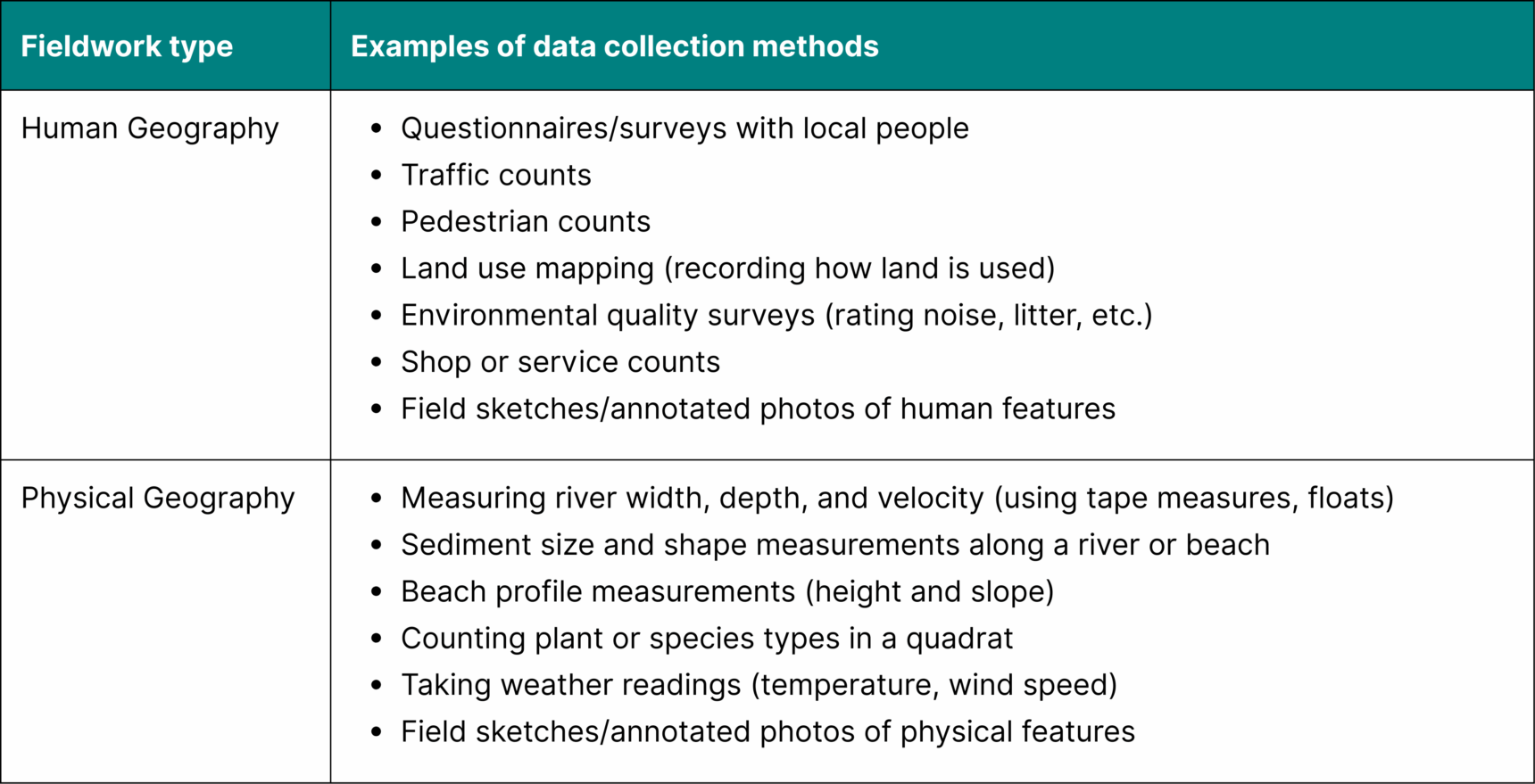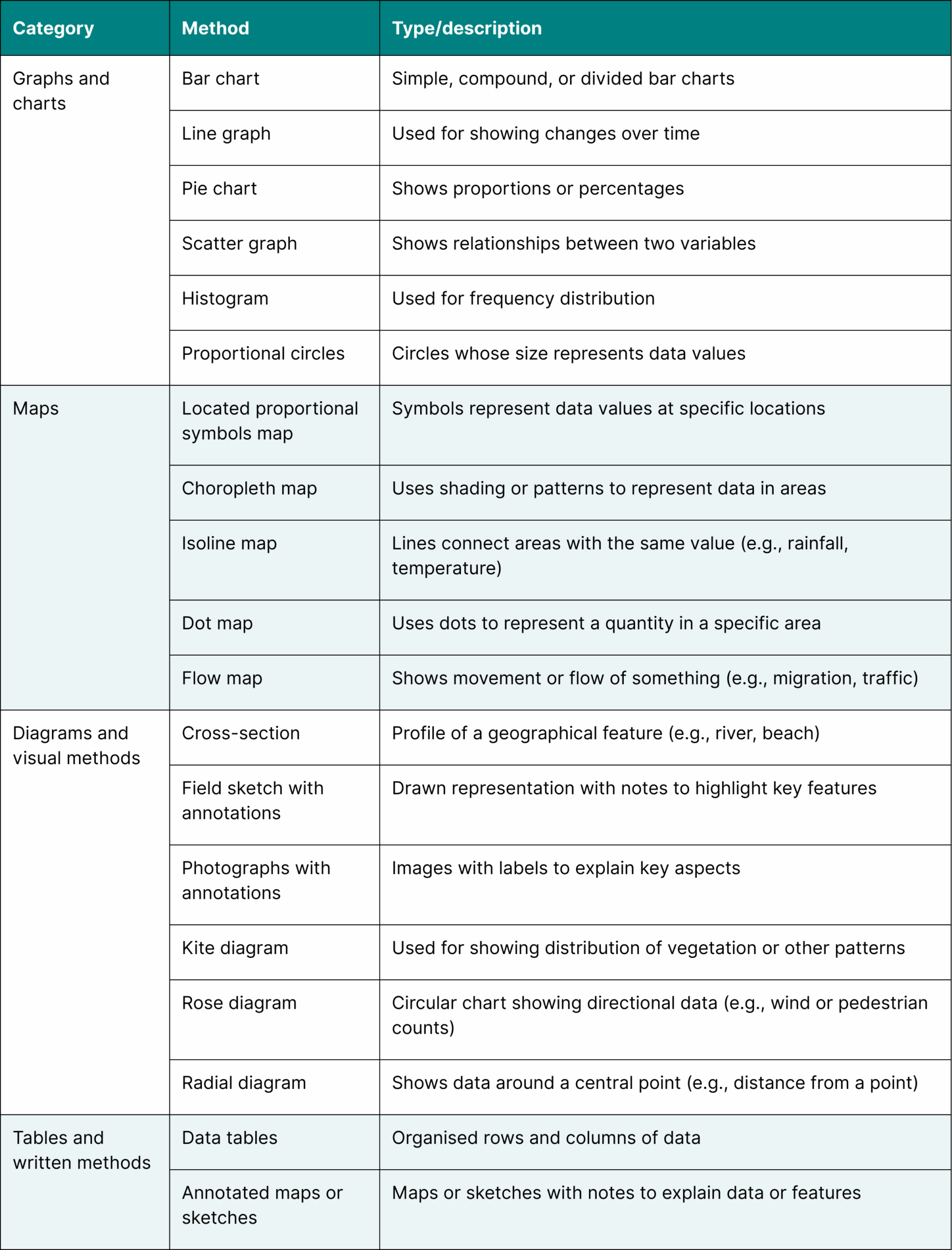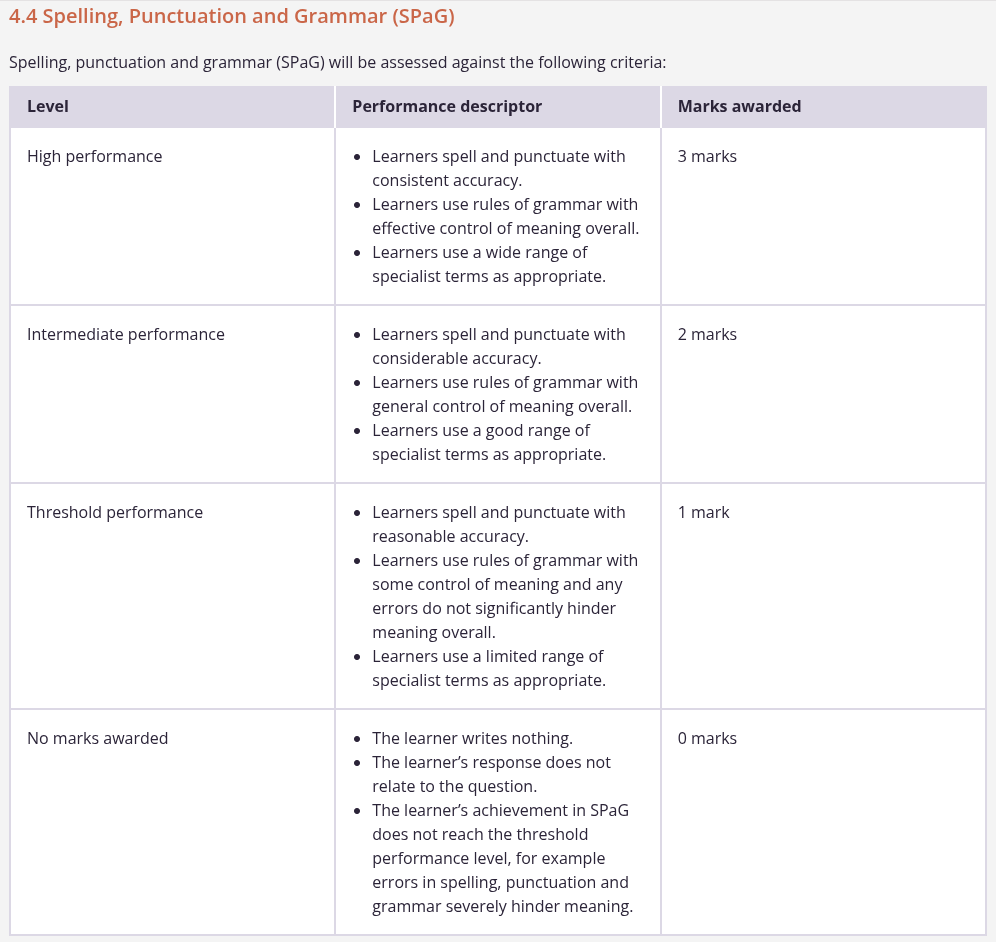Contents:
During my career as a teacher and tutor, the biggest change to the assessment process for AQA GCSE Geography has been the shift from ‘Controlled assessment’ (coursework) to all assessments taking place in examination form.
The newest paper to be added to the qualification is Paper 3: Geographical applications. This was first examined in 2018 and has been set every year since.
What is assessed in Geography Paper 3?
If you’ve already looked at past papers, you may have noticed some changes to the format due to Covid and lockdown adjustments. However, we have now returned to the original exam format, which splits the paper into two distinct sections:
- Section A: Issue Evaluation
– Based on a pre-release case study
– Tests analysis, evaluation, and decision-making skills - Section B: Fieldwork
– Questions on unfamiliar fieldwork tasks
– Questions based on familiar fieldwork you have completed in school
The paper is worth 30% of your final GCSE.
In my opinion, there is no other examination like this, and it needs to be attempted in a different way to traditional examinations. There is a big focus on skills in Geography Paper 3, which you have been practising since KS3. This is a chance for you to show off these skills and ‘Think like a geographer!’

What is the Geography Paper 3 Issue Evaluation?
In Section A: Issue Evaluation, you’ll get to show your critical thinking and geographical skills by exploring a real-world issue using information provided in a pre-release resources booklet. You’ll apply what you’ve learned in both physical and human geography to understand the issue from different viewpoints, analyse the pros and cons, and explain which solution you think works best and why.
12 weeks before the exam, you’ll get the pre-release booklet to help you prepare. In the exam, you’ll use a clean copy to answer questions and write an extended response that shows your judgement and reasoning.
What is the Geography Paper 3 pre-release booklet?
The pre-release resources booklet introduces a new case study linked to one or more of the topics you’ve studied in GCSE Geography.
The booklet includes a mix of resources like maps, graphs, photos, and text, as well as important viewpoints from stakeholders, which you’ll use in your longer answers and when making decisions in the exam.
The pre-release document isn’t publicly available and can only be given to students by their school.
Which topics have appeared in the Issue Evaluation so far?
Each year, the Issue Evaluation is based on a different topic linked to real-world geographical challenges—here’s a list of the themes that have appeared in previous exams:
- (2018) Water in the United Kingdom
- (2019) Tropical rainforests
- (2020) Urbanisation
- (2021) The changing pattern of energy production and use in the UK
- (2022) Managing waste in the UK
- (2023) Tourism and development
- (2024) UK Housing Challenge
- (2025) UK Energy

What types of questions are in the Issue Evaluation section?
You’ll see a mix of question types, including multiple-choice, short-answer, levels of response (like explain or assess), and extended prose questions.
Some of the lower-mark questions will ask you to work directly with the pre-release booklet, using your numeracy and map skills—for example, measuring distances on maps or analysing graphs.
The final and most important question usually asks you to make a decision about the issue, using evidence from the booklet and your geography knowledge. You’ll need to write a well-structured argument, explain your opinion, and suggest what action should be taken.
For example, in the 2023 exam, students were asked:
“Do you think that the cruise ship terminal and port facility development proposed by the Cayman Island government in 2019 should go ahead?”
Top tip!
Although we don’t know the exact question for this summer’s paper, it’s a good idea to practice planning an answer around a decision or judgement—for example, whether or not a development project should go ahead.
How is the 9-mark question assessed?
The 9-mark decision question at the end of Section A is marked using Assessment Objectives AO3 (interpret, analyse and evaluate geographical information and issues to make judgements) and AO4 (investigate issues and communicate findings).
It’s your chance to show high-level thinking and your evaluation skills. To reach the top level, you need to apply your knowledge and understanding thoroughly using information from the pre-release document. This means going beyond simple description—you should develop your ideas using a wide range of evidence from the resources, making clear, specific links between different parts of the specification.
You also need to communicate your ideas clearly, using accurate geographical language. It’s not enough to just list facts from the booklet or write a general opinion—you need to use the data provided to back up your judgement, drawing out and developing points in detail.
Strong answers show a well-reasoned, balanced argument that leads to a supported and thoughtful conclusion.

How can you prepare for the Issue Evaluation section of Paper 3?
You’ll have 12 weeks to prepare using the pre-release resource booklet your teacher gives you. This booklet is yours to write on, highlight, and annotate—so make the most of it! Highlight key points, add notes next to graphs and maps, and consider making mind maps or summaries for each figure to help you understand and remember the material.
Different schools and teachers will prepare you in slightly different ways, so make sure to use your teacher’s advice and experience, and work through any practice questions or examples they give you.
Top tip!
During the 12 weeks, keep re-reading the booklet so you can remember the main points and, more importantly, know where to quickly find useful information when you’re in the exam.
Section B: Fieldwork
The second half of AQA GCSE Geography Paper 3 focuses on fieldwork and is divided into two parts.
First, you’ll answer questions on unfamiliar fieldwork, where you’re given data from an investigation another student has completed. This could include graphs, maps, tables, or photos, and you’ll be asked to interpret the information, comment on the methods used, and evaluate the investigation. These questions test your understanding of fieldwork skills in a general sense—not your own specific experience.
After that, you’ll move on to your own fieldwork. Here, you’ll be expected to recall details from the fieldwork you carried out in school, including your hypotheses, data collection methods, presentation techniques, results, and conclusions. You may also be asked to reflect on how effective your methods were and suggest ways to improve. It’s important to revise both parts carefully, as together they make up a significant portion of the paper.
What is unfamiliar fieldwork?
In Paper 3, you will be given unfamiliar fieldwork—this means fieldwork carried out by other GCSE students that you will not have seen before the exam. You will be asked to complete a range of tasks based on this fieldwork. This could include suggesting possible data collection methods (for example, how the students could have gathered their data), recommending data presentation methods (such as which types of graphs, charts, or maps would be suitable), and completing partly finished data presentation tasks like finishing off a graph or filling in missing labels.
You may also be asked to analyse data by looking at patterns, trends, or relationships shown in the presentation methods, and to evaluate the fieldwork by identifying strengths, weaknesses, and how reliable the conclusions are.

How do I revise for unfamiliar fieldwork questions in Geography Paper 3?
You will be using similar skills to the familiar fieldwork part of the paper, and a good understanding of the different skills you used during your fieldwork will help you greatly.
You will also need to make sure you complete as many past paper questions as possible, as this will show you the variety of questions you may face and give you an opportunity to use your geography skills. You can find AQA Geography Paper 3 past papers and mark schemes on Physics & Maths Tutor.
What do you need to know about familiar fieldwork?
Fieldwork is an important element for all geographers and is part of the GCSE specification. Before the summer examination period, you will need to complete two pieces of fieldwork, using your own data collected outside school in two very different environments.
One of these should show how physical and human geography interact, and both should link to what you’ve learned in class.
What is a hypothesis/key question?
During your fieldwork, you will start with a key question or a hypothesis. The aim of your fieldwork is to answer the key question or to prove or disprove the hypothesis you set.
You will be asked to state your key questions and hypotheses clearly for both your human and physical geography fieldwork—so it’s important to remember them carefully!
What is data collection?
During your visit, you will carry out different activities to collect data that helps answer your questions. The activities you do will depend on the location of your fieldwork and the equipment available.
Below is a table with some examples of data collection methods.

You need to remember the different data collection methods you completed during your fieldwork. You may be asked to describe these and explain how they help you to answer the hypothesis or key question. For higher mark questions, you may be asked to reflect on the accuracy and reliability of each of the methods.
What data presentation methods did you use?
After completing your fieldwork and returning to school, you will have gathered (collated) data for whatever you were investigating. With the help of your teacher, you will then present your data. It’s important to present your data in an appropriate way, using a suitable graph, map, or other data presentation method.
During your data presentation lessons, you will discuss the different choices you made, and it’s important to remember these for the exam, as you may be asked about which presentation methods you used and why you chose them.

What is data analysis?
Once you have finished presenting your data, you will have the chance to analyse and explain your results. Start by describing your data to explain what you’ve collected. Then, move on to analysing the data, looking for patterns, trends, or connections between different pieces of information. This will help you start explaining your results and answering your hypothesis or key questions.
To support your conclusions, you’ll need to use simple statistics. This could include calculating averages, ranges, or percentages to summarise your findings.
Finally, look for any anomalies—data that doesn’t fit with the rest. Anomalies could be important and might give you additional insights. You’ll need to explain why they might have occurred.
The data analysis will help you draw conclusions about your fieldwork and give you a better understanding of your results.
In the exam, you might be asked about how you analysed your collected data, including any anomalies, and which statistical tests you used. You may also be asked whether the statistical tests you chose were appropriate for your data.
What is a conclusion?
From your data analysis, you will form conclusions that link your data to your hypothesis or key questions. This will give you a final answer for your fieldwork.
In the exam, you may be asked about your conclusion and how you reached it. You might also be asked about the reliability of your conclusion, which can be addressed in your evaluation.
What is an evaluation?
An evaluation is when you reflect on your fieldwork and assess how reliable your results are. You need to identify any problems with your data collection methods, recognise limitations in the data you gathered, and suggest other data that might have been useful.
Finally, you should evaluate the reliability of your conclusions and consider how confident you are in your findings.

How do I revise for familiar fieldwork questions in Geography Paper 3?
Every school will have completed the familiar fieldwork in a different way and displayed/collated the data in a variety of ways.
What you need to do before you leave school is make sure you have all your information from your fieldwork in a usable format. I would suggest summarising the fieldwork into one document, so it is easy to access and to revise. I would also recommend accessing past paper questions (available on Physics & Maths Tutor) and attempting as many questions as possible, linking your answers to your completed fieldwork.
How to score extra SPaG points in the 9-mark questions
The final question for both sections of the paper (Issue Evaluation and Fieldwork) is worth 9 marks, plus an extra 3 marks for SPaG (spelling, punctuation, and grammar)—so it’s important to write clearly, use good English, and organise your ideas well.
Here are the full details of how SPaG is marked:

Source: AQA
Geography Paper 3 is your opportunity to apply everything you’ve learned, from evaluating real-world issues to reflecting on your own fieldwork experiences. With clear preparation using the pre-release booklet, a strong grasp of fieldwork skills, and practice answering exam-style questions, you can approach this paper with confidence.
FAQS
How many marks are available for AQA Geography Paper 3?
There are 76 marks available in total for Paper 3.
How long is Geography Paper 3?
Each AQA GCSE Geography paper, including Paper 3, is one hour and 30 minutes long.
What is the weighting of Paper 3 for the AQA GCSE Geography qualification?
Paper 3 is weighted slightly less than the other two papers at 30%.
Do I take my pre-release resource booklet into the exam?
No—you can’t take in your own pre-release booklet, but your school/exam centre will give you a clean copy of the same booklet to use in the exam.
How many marks are available for the Issues Evaluation?
37 marks are available for the Issue Evaluation element of Geography Paper 3.
How long should I spend on the Issue Evaluation in Paper 3?
You need to spend around half the allocated time for the paper, which is around 45 minutes.
Do I take my fieldwork data into the exam?
No—you need to remember your fieldwork data and what you did with this.
How many marks are available for the Fieldwork part of Paper 3?
39 marks are available for the Fieldwork element of Geography Paper 3.
How long should I spend on the Fieldwork part of Paper 3?
You need to spend around half the allocated time for the paper, so this will be around 45 minutes.








Very helpfull my 12 year old has her GCSE geography paper 3 tomorrow and this helps a lot.
Many thanks,
Bobaga Grueela
12 year old!?